| Phone / Voicemail / text 707-875-2911 | Visit our Showroom | About Us | E-Mail US | |||||
| Linda Sorensen Paintings .com |
Joshua Meador Collection |
Vintage Prints | ||||||
|
|||||||||||||||||||||||||||
| Bodega Bay Heritage Gallery January 2023 Newsletter |
|
new from Linda Sorensen |
an online gallery located in Bodega Bay, California, |
Painting of the Month |
|
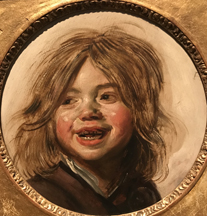 Los Angeles County Museum of Art, Paintings from the Dutch Golden Age |
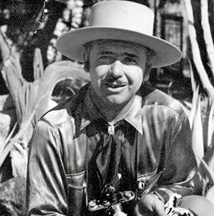 New to us, Scrapbook photos of John W. Hilton |
||
| Bodega Bay Heritage Gallery Notes | |||
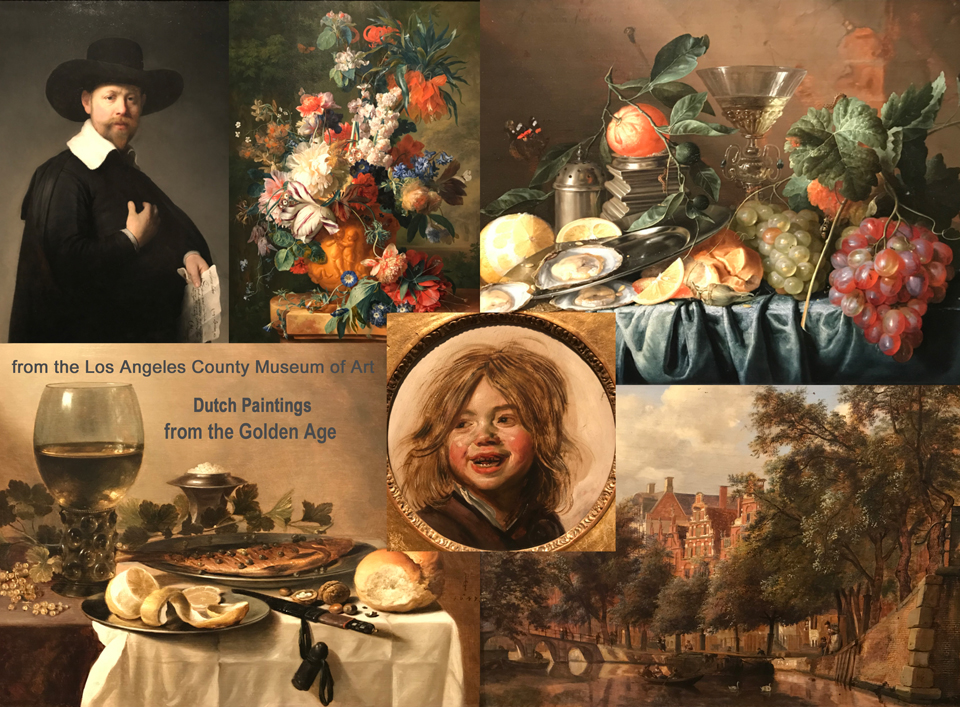 |
|
Los Angeles County Museum of Art |
|
|
This film is from Sydney Australia's Art Gallery of New South Wales for their 2017 exhibition Art from the Dutch Golden Age from the Rijksmuseum in Amsterdam. |
|
|
| Biblical themes | |
This transition from Biblical and classical themes to Dutch secular themes was not abrupt. There were a few biblical and classical paintings produced, but these Biblical paintings definitely had a Dutch accent. Their use of lighting is very Dutch. The furnishings, clothing, and props found in these pictures are from the 17th century. |
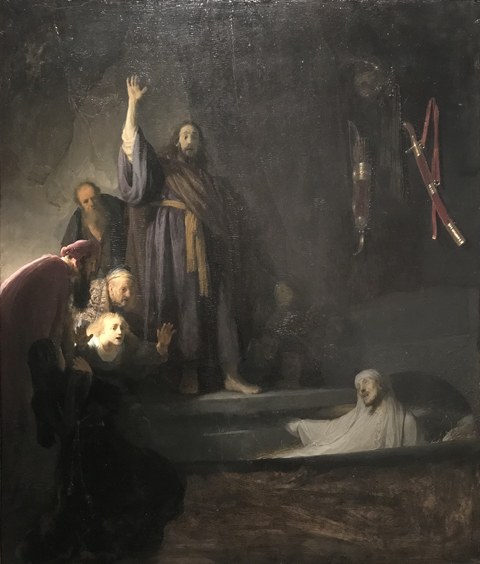 The Raising of Lazarus, c1630-32 Rembrandt van Rijn, 1606-1669 |
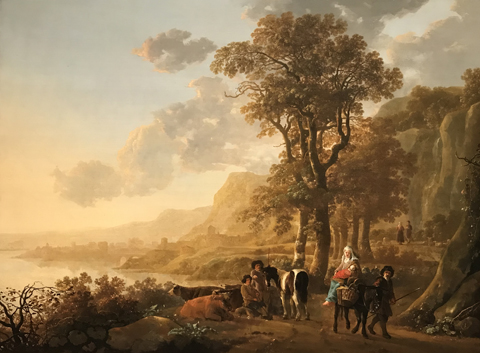 The Flight to Egypt, 1655 Aelbert Cuyp, Northern Netherlands, 1620-1691 |
|
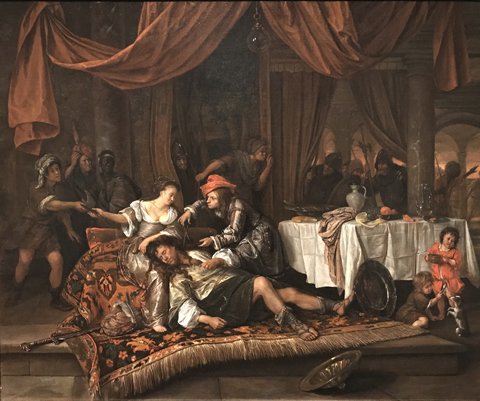 Samson and Delilah, 1668 Jan Steen, Northern Netherlands, 1626-1679 |
Aelbert Cuyp never traveled to Italy, but he was influenced by Italian paintings. In The Flight to Egypt, The painting includes an imagined Northern Italian setting with figures wearing 17th century costumes. |
| Still life, floral and banquet | |
 Still Life with Herring, Wine and Bread, 1647 Pieter Claesz, Northern Netherlands, 1596/97-1660 |
|
Dutch scenes of banquet tables are sumptuous and visually appetizing. These tables are set with an array of exotic treats from far away as well as the bounty from the sea brought in from the Dutch fishing fleet. They often featured a carafe or glass of wine with excellently executed light reflecting from a rounded surface. The tables are often draped by exquisitly rendered tablecloths. |
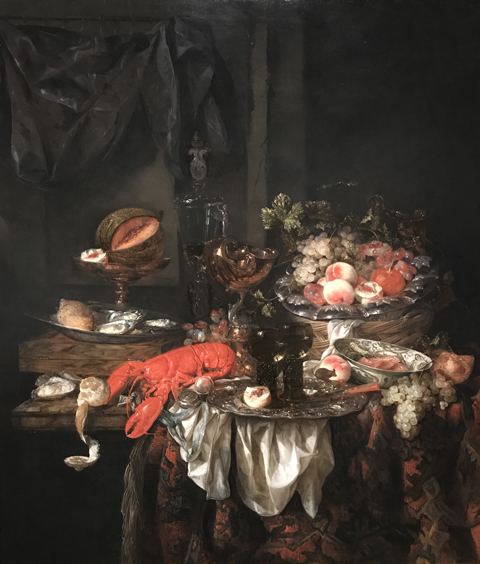 Banquet Still Life, 1667 Abraham van Beyeren, Northern Netherlands, 1620/21-1690 |
 Still Life with Oysters and Grapes, 1653 Jan Davidsz. de Heem, 1606-1684 |
|
Jan Davidsz de Heem's Still Life with Oysters and Grapes appears to show part of a table after the guests have had their way with its offerings. An oyster seems to be sliding off the silver plate and crumbs are on the table. Again, the exotic citrus and the reflected light upon the glass are a treat for the eyes. It shows the love the Dutch had for fancy entertaining, the offering of exotic fruits, here garnished with grape and orange leaves. |
|
 Game Market, 1630's, Frans Snyders, Flanders (now Belgium), 1579-1657 |
|
It's been nearly 400 years since Game Market by Frans Snyders was painted. Apart from its artistic qualities, it shows the huge differences between how meat is processed and sold in the 17th century compared with the 21st. This painting is evidence of the abundance of game in the Dutch countryside. At that time, only noblemen were permitted to hunt and sell game. This retail display of abundance is for wealthy customers. Frans Snyders is known for his still lifes, animal paintings and hunting scenes. |
|
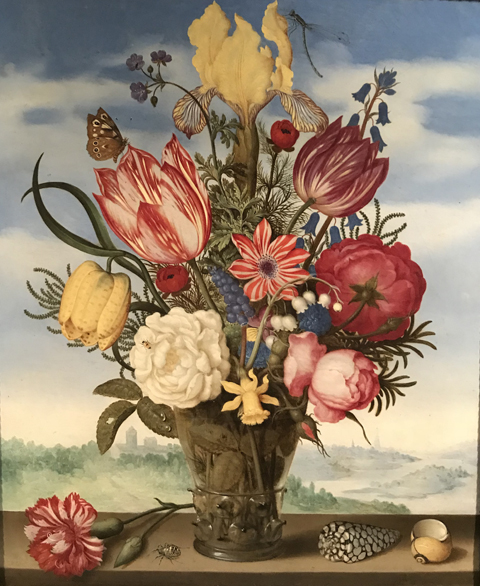 Bouquet of Flowers on a Ledge, 1619 Ambrosius Bosschaert, Northern Netherlands, 1573-1621 |
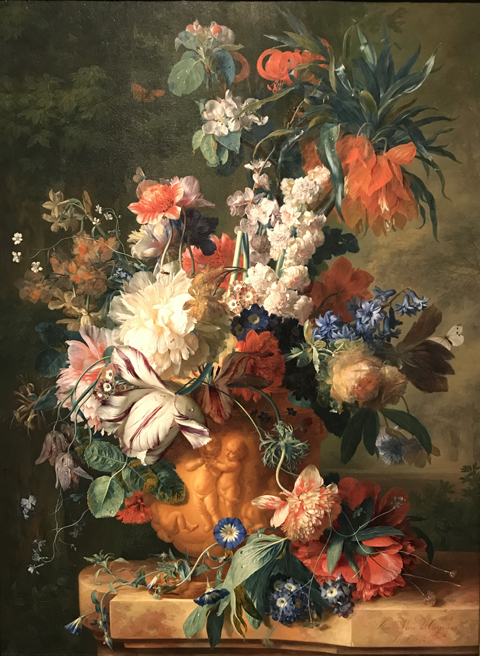 Bouquet of Flowers in an Urn, 1724 Jan van Huysum, Northern Netherlands, 1682-1749 |
Bouquet of Flowers on a Ledge by Ambrosius Bosschaert shows a glass vase on a window ledge. The arrangement is a mix of both common and exotic flowers, including a prized imported striped tulip. The Dutch love of cultivating, displaying and trading tulip bulbs exists to this day. This bouquet is imagined, because the blossoms displayed bloom at different times of the year. Notice the butterfly on the striped tulip to the left, a feature found in many of Bosschaert's floral paintings. |
|
| Portraits | |
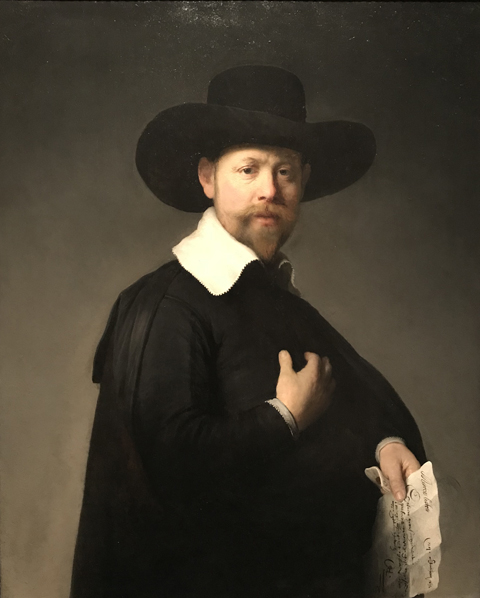 Portrait of Marten Looten, 1632 Rembrandt van Rijn, Northern Netherlands, 1606-1669 |
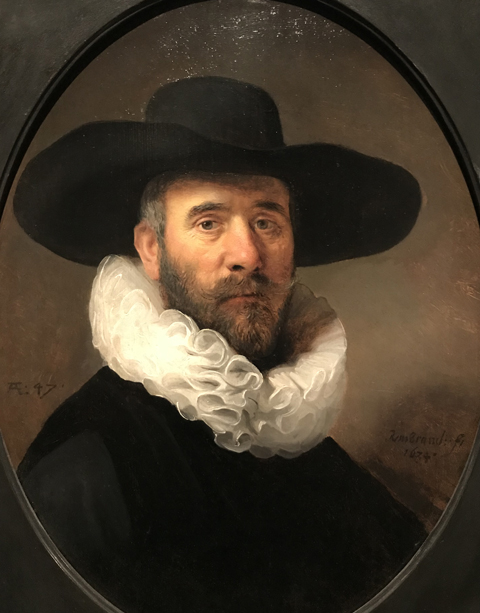 Portrait of Dirck Jansz. Pesser, c1634 Rembrandt van Rijn, 1606-1669 |
|
|
 Portrait of Pieter Tjarck, c1635-38 Frans Hals, 1582/83-1666 |
 Laughing Child, c1620-25 Laughing Child, c1620-25Frans Hals, 1582/83-1666 |
Frans Hals was born 23 years before Rembrandt. He is best known for his portraits of wealthy patrons. He employed an intimate realism with a radically free approach, capturing aspects of his subject's personality by enlivening their pose and facial expression. He is popular today because his subjects are interesting and relatable. Portrait of Pieter Tjarck, a wealthy silk merchant in Haarlem, strikes a casual pose holding a pink rose. This portrait was a companion portrait of Marie Larp, Tjarck's wife (at the National Gallery, London). The portraits were done on the anniversary of their wedding in 1834. |
|
| Church Interiors | |
 Interior of a Gothic Cathedral, 1612 Paul Vredeman de Vries, 1567-after 1630 |
|
The premier painter of church interiors was Emanuel de Witte, 1617-1692. He was not religious at all but was artistically attracted by the angles, vertical space, and shadows to be found within church interior's architecture. But he was not the first to paint the interiors of churches. |
|
 Interior of the Nieuwe Kerk in Delft with the tomb of William the Silent, 1653 Emanuel de Witte, Northern Netherlands, c 1617-1692 |
William the Silent was the hero of Dutch resistance against Spain. He was assassinated in 1584. His tomb is pictured here in de Witte's painting, Interior of Nieuwe Kerk in Delft. The monument over his crypt was a popular national attraction. Notice the dog next to a man with a red cape. Dogs accompanying individuals into churches and other places of business was not an unusual sight in the 17th century. In this painting, de Witte creates an illusion. His painting appears to be of a finished painting, partially covered by a curtain hanging over it. |
 Interior of the Oude Kerk, Amsterdam, c1659 Emanuel de Witte, c1617-1692 |
|
Today, Oude Kerk is Amsterdam's oldest building. The current stone structure was consecrated in 1306 as a Roman Catholic Church. In 1578, the church was taken over by the Calvinist Dutch Reformed Church when Dutch national hero William the Silent defeated the Spanish in the Dutch Revolt. Rembrandt was a frequent visitor to the Oude Kerk and his children were all christened in it. Emanuel de Witte's Interior of the Oude Kerk, Amsterdam, shows a portion of its famed wooden ceiling. Here again, notice the dog next to the man holding a red cape against the pillar in the lower right of the painting. Seeing these paintings side by side, its easy to assume de Witte loved dogs and, as a painter, he loved adding a dash of red to his paintings. |
|
| Dutch Harbor Scenes | |
 View of the River Maas near Dordrecht, NL, 1644-45 Aelbert Cuyp, 1620-1691 |
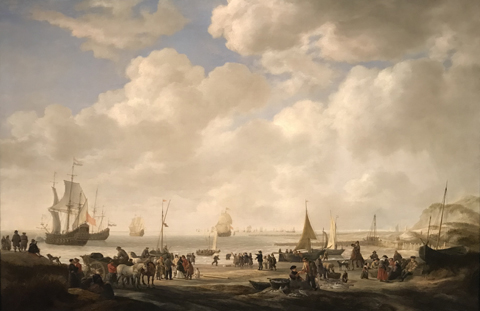 View of a Beach, 1646 Simon de Vlieger, 1600/01-1653 |
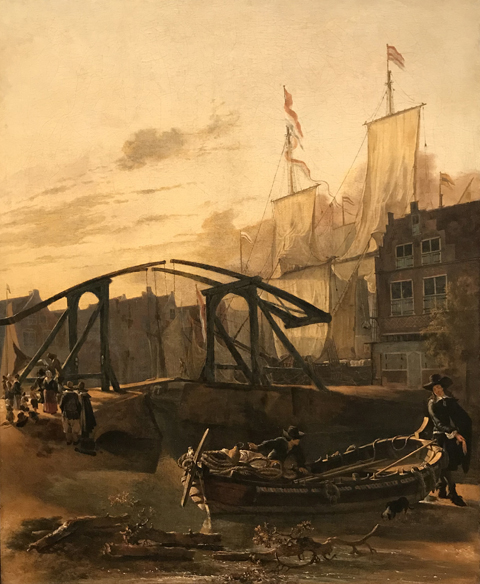 View of a Harbor in a City (Schiedam?), c1650-1653 Adam Pynacker, Northern Netherlands, 1620-1673 |
View of the River Maas near Dordrecht, Netherlands is the left half of a long panel showing a panoramic view of Dordrecht from across the River Maas. Aelbert Cuyp was a native of Dordrecht. The right side of this painting hangs in the Museum der Bildenden Kunste in Leipzig, Germany. |
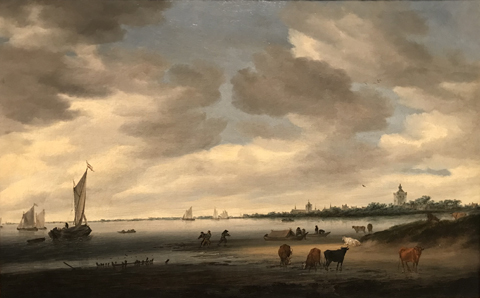 View of the River Lek and the town of Vianen, 1668 Salomon van Ruysdael, Northern Netherlands, 1600/03 - 1670 |
|
In View of a Harbor City, which Adam Pynacker painted when he was in his early 30's, tall flagged masts and sails can be seen in the background while in the foreground, two men wrestle to launch a much smaller vessel. In his late 30's, Pynacker made an extended visit to Italy where he converted to Catholicism in order to marry Eva Maria de Geest. Her father Wybrand de Geest was a famed Dutch portrait painter. |
|
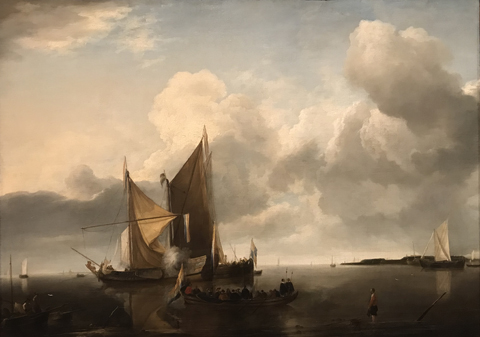 Ships in a Calm, c1650-1655 Jan van de Cappelle, Northern Netherlands, 1626-1679 |
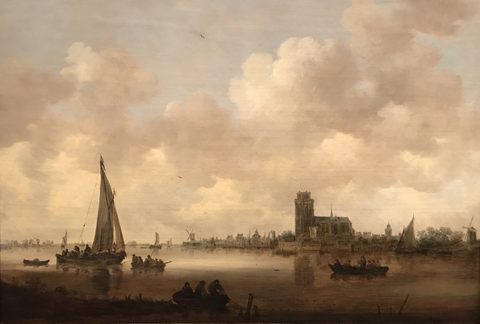 View of Dordrecht, 1645 Jan van Goyen, Northern Netherlands, 1596-1656 |
Ships in a Calm by Jan van de Cappelle is representative of many maritime paintings of Dutch trading ships close to shore. He was one of the leading Dutch maritime painters. He was a man of many talents. After buying a home in Amsterdam, he devoted most of his energies to business. Besides being a Dutch painter, he was a major collector of Dutch art. Here too, light and sky dominate this painting. |
|
 View of Arnhem, 1646 Jan van Goyen, Northern Netherlands, 1596-1656 |
|
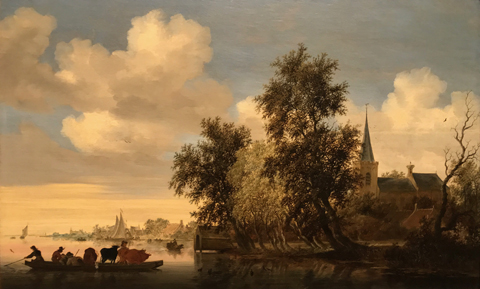 River Landscape with a Ferry, 1650 Salomon van Ruysdael, Northern Netherlands, 1600/3-1670 |
|
Salomon van Ruysdael's River Landscape with a Ferry is similar to View of the River Lek and the town of Vianen. But here, van Ruysdael shows us a typical scene in Dutch life, a ferry crossing a river. The low and flat Dutch landscape is crossed by wide shallow rivers. Ferries were a frequent aspect of Dutch life and were often a subject of van Ruysdael's paintings. |
|
| Dutch Landscapes | |
 Landscape with Peasants Playing Bowls Outside an Inn, c1660 David Teniers the Younger, Southern Netherlands, 1610-1690 |
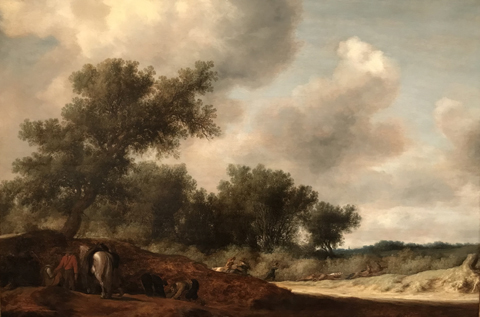 Landscape with Deer Hunters, c1630 Salomon van Ruysdael, Northern Netherlands, 1600/03-1670 |
Landscape with Peasants Playing Bowls Outside an Inn by David Tiers the Younger is an homage of sorts to his father, Jan Brueghel the Elder. His father was fond of playing bowls. This painting is typical of David Teniers the Younger with an expanded landscape in the background giving the painting an overall pastoral mood. This is a large painting, probably commissioned by owners of a large estate. |
|
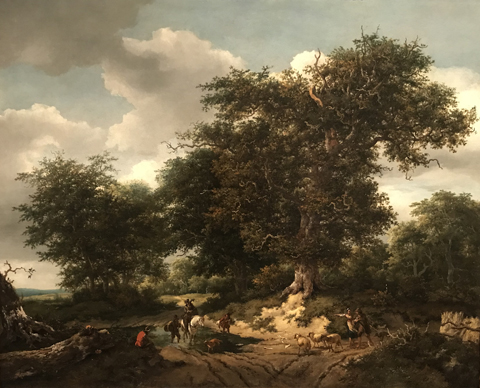 The Great Oak, 1652 Jacob van Ruisdael, Northern Netherlands, 1628-1682 ... and Nicolaes Berchem, Northern Netherlands, 1620-1683 |
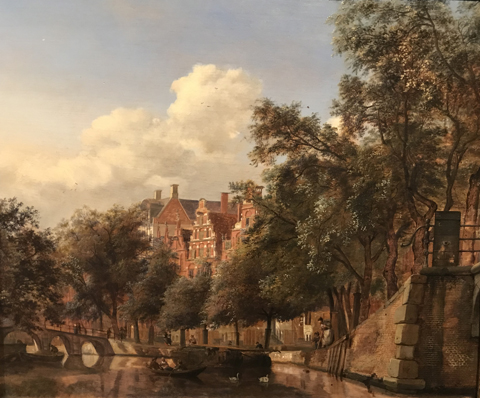 View of Herengracht, Amsterdam, from the Leliegracht, c1660-70 Jan van der Heyden, Northern Netherlands, 1637-1712 |
Jacob van Ruisdael was the nephew of Solomon van Ruysdael. He is the better known painter of the two. Jacob was known as a most versatile painter of landscapes. His compositions are nearly heroic and his observation of detail was most keen. The Great Oak is a collaboration with Jacob's friend, artist Nicolaes Berchem. Nicolaes did the figures of Italian shepherds, a gentleman and discharged soldiers moving through Jacob's light filled northern landscape. The battered old oak clinging to the sand into which it is rooted dominates this landscape. Nearly a century after this painting done in 1652, it resided in Rome in the famous collection of Cardinal Silvio Valenti Gonzaga. |
|
 Landscape with Dunes, 1649 Jacob van Ruisdael, Northern Netherlands, 1628-1682 |
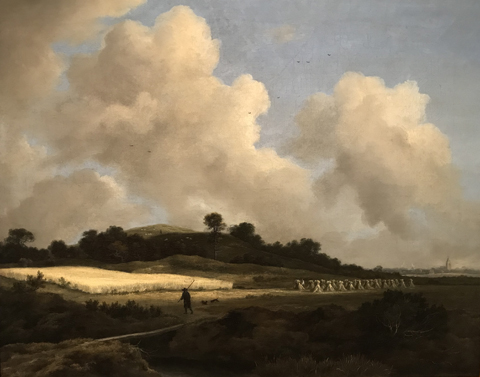 View of Grainfields with a Distant Town, 1650 Jacob van Ruisdael, Northern Netherlands, 1628-1682 |
Landscape with Dunes by Jacob van Ruisdael is a pleasing scene of a roadside crossing a stream beneath a billowing cumulus cloud. Again, van Ruisdael pictured oak trees rooted in the sand, giving dimension to the otherwise low lying dunes. |
|
 Landscape with a Footbridge, 1664/65 Meindert Hobbema, Northern Netherlands, 1638-1709 |
 Landscape with Anglers and a Distant Town, 1664/65 Meindert Hobbema, Northern Netherlands, 1638-1709 |
|
|
| New to us, Scrapbook photos of John W. Hilton by Daniel Rohlfing |
|
|
|
Recently, a new client expressed interest in our John W. Hilton prints. After retrieving the print portfolio from storage I discovered (or rediscovered) these photos, laid out in a collage on the back inside cover. |
|
 James Cagney, sketching his friend and neighbor John W. Hilton as Hilton paints in his Twentynine Palms studio. (photo from the back jacket of The Man Who Captured Sunshine by Hilton biographer and lifelong friend, Katherine Ainsworth) |
|
John counted many people his friends, from notables like President Eisenhower, General Patton, James Cagney and industrialist Howard Hughes to local folk, including native Americans, Hispanics, business and trades people, and kids. |
|
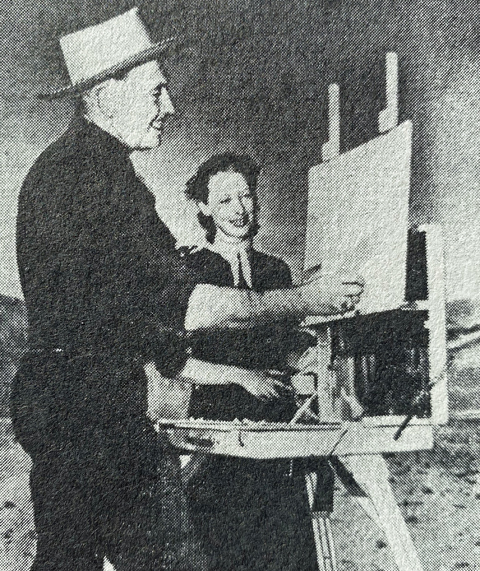 John Hilton at his plein air easel with wife Barbara looking on. |
|
Barbara was the true love in John's life. He first saw her on a chance meeting when John had stopped in at his old gem shop in Thermal, California, just to pick up a few things and take them to his new home in Twentynine Palms. |
|
John noticed an old customer who had bought some of John's paintings walking across the road from Valerie Jean's Date Shop. A woman in curlers and a scarf was with him. As they got closer, John was enchanted by the woman. Clumsy small talk gave way to continued conversation, and in short order, John and Barbara courted and were married. |
|
|
 John Hilton is shown here with his mother Blanche. She unveiled a John W. Hilton painting to the Church of the Brethren Seminary in honor of her husband and John's father, Rev. George W. Hilton, and the family's 6-year mission to China. |
In mid 1909, Blanche was not only mothering a 5 year old son, she was responsible for her family's upkeep and welfare and worked as her husband's chief mission assistant. When George suffered a debilitating knee injury and had to return to the United States for surgery, Blanche tended to the details to make the long trip home possible. |
|
 This blurry photo is taken from an old brochure for Santa Ana's Saddleback Inn, the only photo I have found showing John W. Hilton's two large murals at the Saddleback Inn in Santa Ana, CA. Back in the 1960's and 1970's, the Saddlebackl Inn's Western Art Gallery was where many of California's great desert painters exhibited their work. |
|
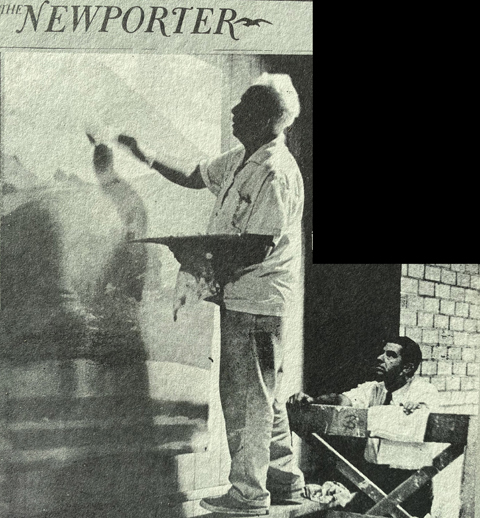 John W. Hilton standing on scaffolding while painting one of two large murals in the banquet room of the Saddleback Inn. Watching is Bill Riffle of the Western Art Gallery, located at the Saddleback Inn. |
|
The Saddleback Inn's Murals isn't as interesting a story as his early days as a missionary child in China or the exciting romance he shared with Barbara, but it does bear testament to John's place and prestige in the world of desert painting within the greater Los Angeles art market. |
|
March, '17 John W. Hilton, a man of the desert and like minded friends |
Previous John W. Hilton Articles from our Newsletter |
February, '14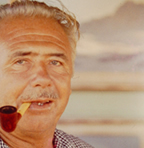 The Valley That Taught Me To Paint by John W. Hilton Desert Magazine, March 1963 |
|
October, '10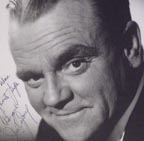 The story of James Cagney & his artist friend, John W. Hilton |
May, '10 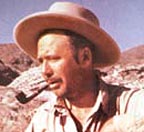 John W. Hilton & General George S. Patton: from The Man Who Captured Sunshine by Katherine Ainsworth |
November, '09  John W. Hilton's 1957 White House Painting for IKE, Twentynine Palms Oasis |
April, '08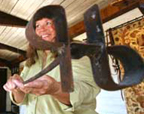 John Hilton's Salton Sea Homehas Historical Site Status |
| These John W. Hilton paintings are available through our gallery | |||
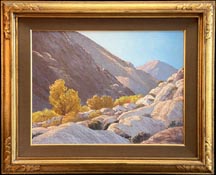 Fall in the Canyon |
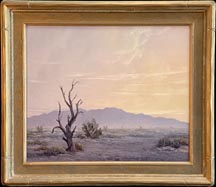 Desert at Evening |
 A Morning in Spring, 1969 |
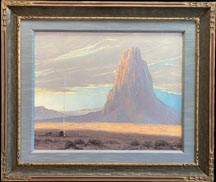 Monument, 1951 |
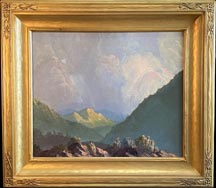 Twentynine Palms, 1950 |
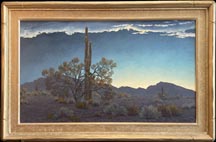 La Mananita, 1963 |
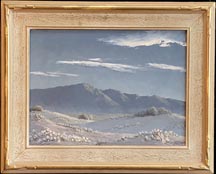 Moonlight in the Dunes |
 Desert Dunes, 1936 |
| John W. Hilton's page | Back to the Top | |||
| Gallery Notes | |
from our Aug 2022 issue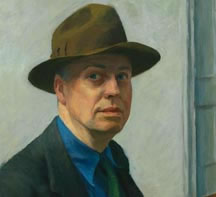 Edward Hopper, A Look Back to a 2008 Exhibition at the Art Institute of Chicago |
A NEW EDWARD HOPPER EXHIBITION
|
Recently, we looked back at the phenomenal Edward Hopper exhibition held at the Art Institute of Chicago in 2008. Now, a new major Edward Hopper exhibition is to be held in New York. Hopper lived in New York for almost 60 years. This exhibition at the Whitney Museum looks at Hopper's paintings of New York. And yes, Night Hawks will be there! |
|
| Link to the Whitney Museum Hopper Exhibition page | |
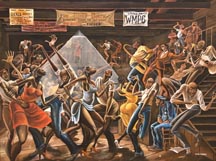 The Sugar Shack, 1976 |
A new record high price for Ernie Barnes at auction We just learned that Ernie Barne's The Sugar Shack (1976) sold for $15.3 million |
In the late summer of 2019, Linda and I visited Los Angeles. Whille there, we took in the Ernie Barnes: A Retrospective exhibit at the California African American Museum in Exposition Park just steps away from the LA Coliseum. WOW! Previously, we knew little of Ernie Barnes, but his art was captivating, fresh and vibrant! He captured the grace of movement found in African American culture, its dance, its music and its athleticism. At the time, I couldn't help but describe it as "visual jazz." Our September 2019 article | Read more on Artnet News |
|
| Jack Stuppin, 1933-2022 |
 |
|
Jack loved Sonoma County's beauty and found great pleasure in painting his virbrant interpretaions of the Sonoma landscape. |
||
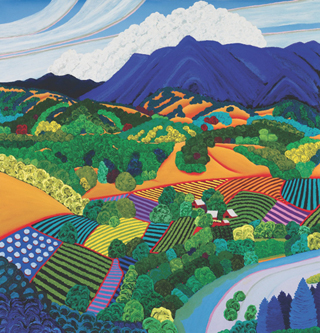 Russian River Rhapsody, Jack Stuppin |
Ten years ago Bodega Bay Heritage Gallery hosted a Jack Stuppin Exhibition, Songs of the Earth, the Color of Joy. It was quite the event, Jack was on hand to meet his friends and fans, offering signed limited edition prints on canvas along with calendars and cards. |
|
| in Bodega Bay | ||
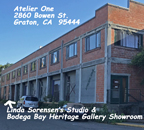 |
Bodega Bay Heritage Gallery Showroom Art Trails 2022 Linda Sorensen's ART TRAILS OPEN STUDIO Sat & Sun, Sepember 24-25, 10-5 Sat & Sun, October 1-2, 10-5 open other times by appointment in Graton or Bodega Bay http://www.BodegaBayHeritageGallery.com | Call or Text 707-875-2911 email: Art@BodegaBayHeritageGallery.com |
 "Mendocino Coast" Joshua Meador |
 Ren Brown |
The Ren Brown Collection 1781 Coast Highway One, Bodega Bay, 94923 707-875-2922 | rbc4art@renbrown.com http://www.renbrown.com | Back to the Top |
 |
Linda Sorensen Paintings LindaSorensenPaintings.com | 707-875-2911 |
 |
|
\ |
Bodega Bay's Jean Warren Watercolors Bodega Bay resident Jean Warren says her paintings are reflections of the places she has lived and traveled. Jean is a signature member of the National Watercolor Society, California Watercolor Association and full member of Society of Layerists in Multi-Media. http://www.JeanWarren.com / 707-875-9240 |
|
| What's nearby? in Sonoma, Napa & Marin Counties |
||
 |
IN SEBASTOPOL - Sebastopol Center for the Arts ... see website for on-line activities home of Sonoma County's Art @ the Source and Art Trails 282 S. High Street, Sebastopol, CA 95472 707.829.4797 Hours when able to reopen: Tue - Fri 10am - 4pm, Sat & Sun 1 - 4pm |
|
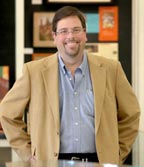 Corrick's Keven Brown |
IN SANTA ROSA Corrick's Art Trails Gallery | http://www.corricks.com/arttrailsgallery 637 Fourth Street, Santa Rosa, CA 95401 | Contact:: http://www.corricks.com/contact-us Corrick's has been a Santa Rosa Treasure since 1915, a downtown stationery store serving the community's "cultural hub." Corrick's has long supported local artists with its impressive "ART TRAILS GALLERY," including paintings by Linda Sorensen. Corricks offers a number of originals by famed Santa Rosa artist, Maurice Lapp ... (see our August 2017 article) located on Fourth Street, steps away from Santa Rosa's revitalized town square and Fourth Street's Russian River Brewery |
 |
 Dennis Calabi |
IN SANTA ROSA- Calabi Gallery | http://www.calabigallery.com We are located at 456 Tenth Street in Santa Rosa. Contact us with any questions at (707) 781-7070 or info@calabigallery.com 456 Tenth Street, Santa Rosa, CA 95401 | email: info@calabigallery.com | 707-781-7070 Famed master conservator Dennis Calabi brings his rare knowledge and experience to present a tasteful and eclectic array of primarily 20th century artwork. http://www.calabigallery.com | Back to the Top |
 Easton, Crustacean Dancing Dream, American Alabaster |
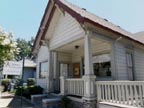 |
IN Santa Rosa - The Annex Galleries specializing in 19th, 20th, and 21st century American and European fine prints The Annex Galleries is a member of the International Fine Print Dealers Association (IFPDA). http://www.AnnexGalleries.com | Back to the Top |
|
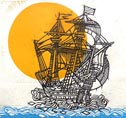 |
IN GRATON - Graton Gallery |
|
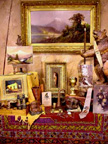 |
IN DUNCANS MILLS - Christopher Queen Galleries 3 miles east of Hwy 1 on Hwy 116 on the Russian River http://www.christopherqueengallery.com |707-865-1318| Back to the Top |
|
 |
IN Healdsburg - Paul Mahder Gallery http://www.paulmahdergallery.com (707) 473-9150 | Info@paulmahdergallery.com 222 Mill Healdsburg Avenue, Healdsburg, CA 95448 | check for hours |
|
 |
|
 |
| Links to current museum exhibits relevant to Early California Art | |||
| The Greater Bay Area | |||
| The Walt Disney Family Museum -- see website for details This museum tells Walt's story from the early days. (on the Parade Grounds) 104 Montgomery Street, The Presidio of San Francisco, CA 94129 -- view location on Google Maps -- |
 |
San Francisco ... see website de Young Museum Permanent Collection |
 |
| San Francisco closed, see website California Historical Society |
 |
San Francisco Legion of Honor ... see website -Permanent European and Impressionist Paintings |
 |
| San Francisco open, see website for details Contemporary Jewish Museum |
 |
Oakland ... see website Oakland Museum of California -- ongoing Gallery of California Art -showcasing over 800 works from the OMCA's collection |
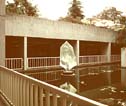 |
San Francisco |
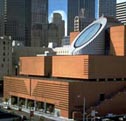 |
Santa Rosa |
 |
| Santa Rosa ... see website Charles M. Schultz Museum |
 |
Moraga |
 |
| Sonoma Mission San Francisco de Solano Museum featuring the famed watercolor paintings of the California Missions by Christian Jorgensen |
 |
Sonoma Sonoma Valley Museum of Art ... see website 551 Broadway, Sonoma CA (707) 939-7862 |
 |
| Ukiah Grace Hudson Museum ... see website http://www.gracehudsonmuseum.org |
 |
Bolinas |
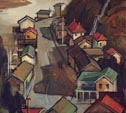 |
| Walnut Creek ... see website The Bedford Gallery, Lesher Center for the Arts |
 |
San Jose San Jose Museum of Art ... see website approximately 2,000 20th & 21st century artworks including paintings, sculpture, new media, photography, drawings, prints, and artist books. |
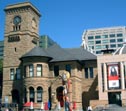 |
| Monterey Monterey Museum of Art ... see website Ongoing exhibitions ... Museums Permanent Collection including William Ritschel, Armin Hansen and E. Charlton Fortune http://www.montereyart.org |
 |
Palo Alto ... see website Cantor Art Center at Stanford University |
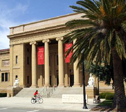 |
Monterey |
 |
Sacramento Crocker Art Museum Open Thurs - Sun, 10-5, masks, ... see websites |
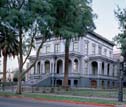 |
| Sacramento Capitol Museum ... see website Governor's Portrait Gallery Permanent Exhibits (including one of our galllery's favorite artists, Robert Rishell's portrait of Gov. Ronald Reagan |
 |
Stockton's Treasure! The Haggin Museum ... see website -Largest exhibition of Albert Beirstadt paintings anywhere, plus the works of Joseph Christian Leyendecker, Norman Rockwell's mentor. see our Newsletter article, April 2011 |
 |
| Southern California (and Arizona) (for all museums below, see website for hours and protocols. | |||
| Los Angeles Los Angeles Museum of Art Art of the Americas, Level 3: Artworks of paintings and sculptures from the colonial period to World War II— a survey of of art and culture & "Levitated Mass" |
 |
Irvine UCI IMCA (University of California, Irvine Institute and Museum of California Art) (formerly The Irvine Museum) The Resonant Surface: Movement, Image and Sound in California Painting ... through Feb 19, 2022 |
 |
| Santa Barbara The Santa Barbara Museum of Art |
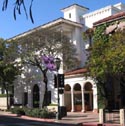 |
Orange Our Golden State: Landscape Paintings from the Hilbert Collection November 9 - April 18, 2022 Hilbert Museum, Chapman University |
 |
| Pasaden Norton Simon Museum -an Impressive Permanent collection, European impressionist and post impressionist paintings See our newsletter from March 2014 |
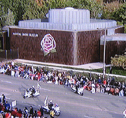 |
San Marino (near Pasadena) The Huntington Library American Art Collection Paintings by John Singer Sargent, Edward Hopper, Robert Henri, Albert Bierstadt, Thomas Moran, William Keith, Mary Cassatt, Thomas Hart Benton and many more. |
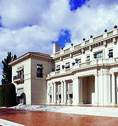 |
| San Diego San Diego Museum of Art Permanent Collection |
 |
Palm Springs |
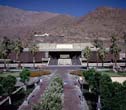 |
| Phoenix, AZ Phoenix Art Museum an excellent sampling of Artists of the American West |
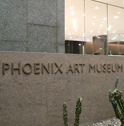 |
Los Angeles California African American Art Museum adjacent to the LA Coliseum (see our newsletter articleof their Ernie Barne's Exhibition September 2019) |
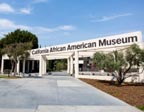 |
| & Beyond | |||
| Honolulu, HI Honolulu Museum (see our Newsletter article from February, 2015) |
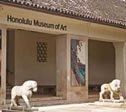 |
Kamuela, HI (Big Island) Issacs Art Center 65-1268 Kawaihae Road Kamuela, HI 96743 (See our Dec '16 article "Hawaii's Paul Gauguin," modernist Madge Tennent, 1889-1972) |
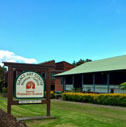 |
| Seattle, WA Seattle Art Museum ( see our article Mar 2018 French and American Paintings ) |
 |
Portland, OR Portland Art Museum Permanent Collection: American Art |
 |
| Washington D.C. The Renwick Gallery Permanent ... Grand Salon Paintings from the Smithsonian American Art Museum |
 |
Chicago, IL Art Institute of Chicago Permanent collection: the Impressionists |
 |
| Cedar Rapids, IA The Cedar Rapids Museum of Art Grant Wood: In Focus is an ongoing permanent collection exhibition. |
 |
Bentonville, AR |
 |
| Washington D.C. The National Gallery Permanent collection American Paintings |
 |
Philadelphia , PA The Philadelphia Museum of Art |
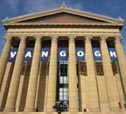 |
| Philadelphia , PA Barnes Foundation, Philadelphia Campus |
 |
Brooklyn, NY The Brooklyn Museum American Art Permanent Collection |
 |
| New York , NY The Whitney Museum of American Art Edward Hopper’s New York Oct 19, 2022 - March 5, 2023 The largest selection of works by Edward Hopper |
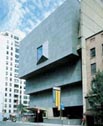 |
New York , NY Metropolitan Museum of Art Its extensive collection of American Art |
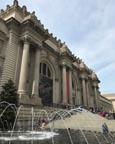 |
| Detroit, MI Detroit Institute of Arts American Art Permanent Collection |
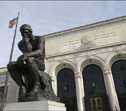 |
Ottawa, Ontario National Gallery of Canada |
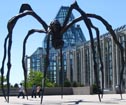 |
| Denver, CO Denver Art Museum |
 |
|
|
|
||||
| For an appointment, email or call ... Art@BodegaBayHeritageGallery.com / 707-875-2911 | ||||
|
||||
|
|
|
||
 |
|
| Bodega Bay Heritage Gallery and Linda Sorensen's studio Bodega Bay Heritage Gallery .com / Linda Sorensen Paintings . com Art@BodegaBayHeritageGallery.com / LindaSorensen@Earthlink.net 707-875-2911 Atelier One, Studio 5, 2860 Bowen St, Graton, CA 95444 (not a mailing address) |
| If you wish to sell a painting to us ... |
|